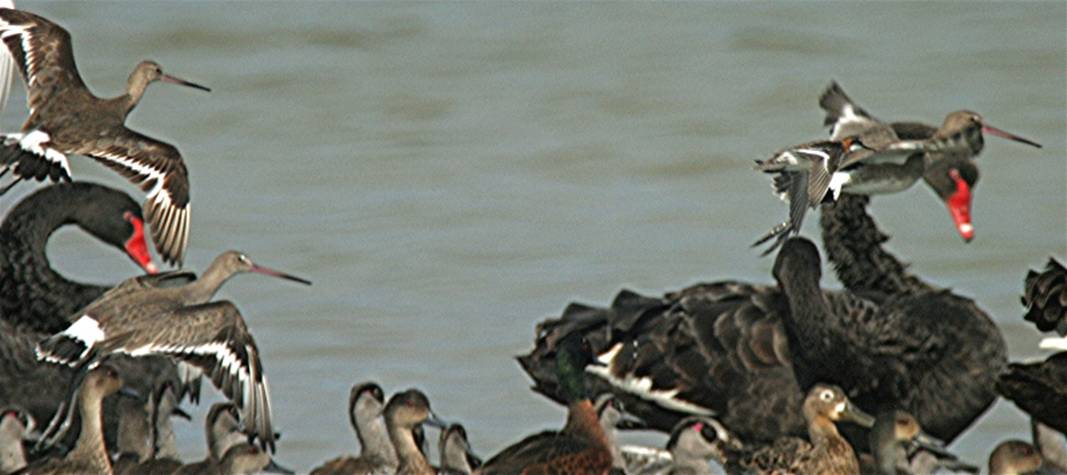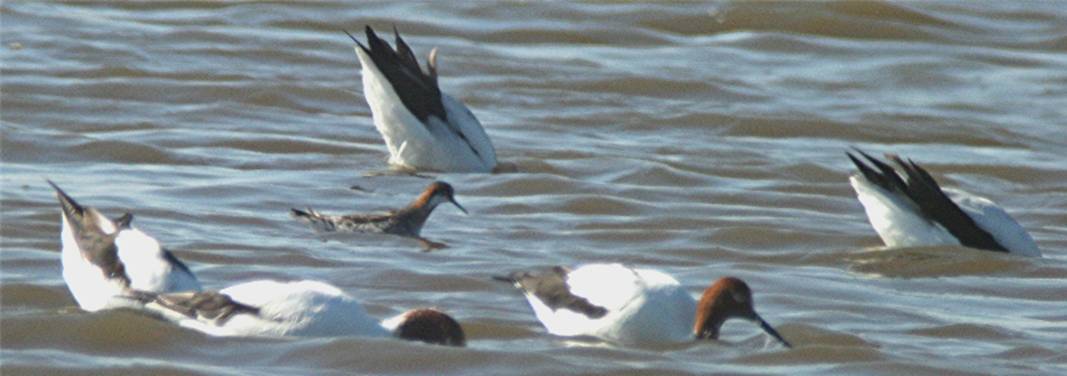G’day all,
I would say that the bird in question is a
rather tatty female Australian Shelduck (Mountain Duck to those who have older
field guides).
Mark
From:
[
Sent: Friday, 10 November 2006
11:10 AM
To: Geoffrey Dabb
Cc:
Subject: Re: [canberrabirds]
Werribee Story
Geoff
What's
that duck below the flying phalarope?
(pale
eye-ring and face)
cheers
Richard
|
"Geoffrey Dabb"
<>
10/11/2006 10:32 AM
|
|
To
|
<>
|
|
cc
|
|
|
Subject
|
[canberrabirds] Werribee Story
|
|
I spent most of the last couple of weeks in Victoria,
in particular checking the waders at Werribee Water Treatment Plant, a vast
wetland on Port Phillip Bay between Geelong and Melbourne. Some of
you will be familiar with it. To start, would you like to try identifying
the flying birds in this photo:

The
main point of interest here is not the Black-tailed Godwits but the Red-necked
Phalarope in breeding plumage, passing abeam of the right-hand swan.
There’s a little story, starting on Monday 30/10, after I’d battled the
peak-hour traffic to acquire my bird-watching permit and shiny new key.
I felt my way along, mainly by seeing which gates would yield to my key, and by
late morning found myself by a lagoon listening to four ‘watchers in a minibus
discussing whether the godwits were bar-tailed or black-tailed. Then
along came Ralph, who’d been having a ‘watch at the You-Yangs, and he said
‘Have you seen the phalarope?’ to which I replied ‘What phalarope?’. It
turned out an RNP had been hanging around for some months but had, strangely,
just acquired breeding plumage in the ‘austral Spring’ (as the waders would
call it if they read the books) and Ralph was keen to see it in its new
colours. There weren’t any phalaropes there just then so Ralph drifted
off. I spent most of the day accumulating material for my ‘variations in
the non-breeding Sharp-tailed Sandpiper’ series that I might inflict on you
next time the ‘are you sure that’s a Sharp-tailed Sandpiper’ discussion occurs.
At
about 5pm I was leaving and stopped to watch some feeding avocets in about the
last pond, when I noticed a smaller bird trailing around after them.
This, it turned out, was not a young avocet, but the phalarope.
When I say it was associating with the avocets, I mean it was REALLY
associating with them, thus:

It was
very windy and the light wasn’t all that good. Barbara and Joy came by
and I pointed out the phalarope to them, and it turned out that they had been
keeping an eye on it for some months. When it took flight with the avocets
they were able to follow it with their binos as it described a great wheeling
loop (more than I could do) and came down at a more distant point on the pond.
I should mention, if you don’t know, that this is a pretty small bird
- about the size of a Sharp-tailed Sandpiper, but of more slender
build.
I was
there for the next couple of days but didn’t see the phalarope again, until
last Saturday when I was driving out along the track that runs by the Little
River (which, you may be aware is the very geographical feature after which the
band was named, although some say it was the railway station) when someone
driving the other way pulled over to let me past. I said to him, having
learned that this was the customary greeting on coming across other local
students of the avifauna, ‘Have you seen the phalarope?’. To my surprise
he said ‘Actually, yes, it’s about 2 or 3 lagoons back on the right’.
So
that was when I took the first snap above, and the one below.

Actually,
I only took a couple of stills, because I wanted some video of the unusual
swivel-and-peck method of feeding but I took a few minutes to assemble my
longest-possible lens arrangement and then I only got a few seconds of footage
before the little chap flew off.

